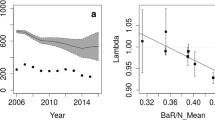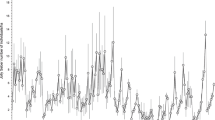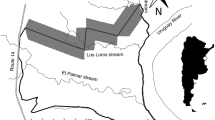Abstract
Population management of herbivores is widely applied to decrease damage to forests in the northern hemisphere. Culling more antlerless deer, including females and fawns, is an effective means of reducing the population and helps to improve management efficiency. To increase the efficiency of antlerless-biased culling, we assessed the spatiotemporal distribution of the antlerless ratio in culled sika deer (Cervus nippon) in relation to population density. We hypothesized that the antlerless ratio is higher at the center of the distribution than at the margins of the deer’s range, because dispersal processes differ according to sex and age: Young male deer first disperse into an unoccupied area, and then males may become established in the new area for approximately 10–15 years before the number of females increases. A statistical model revealed spatiotemporal changes in the antlerless ratio of culled sika deer. The change in the ratio basically fit the density distribution of the deer, which was estimated independently on the basis of fecal pellet count surveys. The antlerless ratio estimated from the model increased asymptotically as deer density rose. The results support our hypothesis and suggest that antlerless sika deer will be more easily culled at the center rather than at the margins of the distribution range. These findings should help to increase the efficiency of managing the deer via antlerless-biased culling.




Similar content being viewed by others
References
Abernethy K (1994) The establishment of a hybrid zone between red and sika deer (genus Cervus). Mol Ecol 3:551–562
Abrahms B, Aikens EO, Armstrong JB, Deacy WW, Kauffman MJ, Merkle JA (2021) Emerging perspectives on resource tracking and animal movement ecology. Trends Ecol Evol 36:308–320
Allen AM, Singh NJ (2016) Linking movement ecology with wildlife management and conservation. Front Ecol Evol 3:155
Apollonio M, Andersen R, Putman R (2010) European ungulates and their management in the 21st century. Cambridge University Press, Cambridge, p 618
Barrowman NJ, Myers RA (2000) Still more spawner-recruitment curves: the hockey stick and its generalizations. Can J Fish Aquat Sci 57:665–676
Bartoš L (2009) Sika deer in continental Europe. In: McCullough DR, Takatsuki S, Kaji K (eds) Sika deer: biology and management of native introduced populations. Springer, Tokyo, pp 573–594
Beverton RJH, Holt SJ (1957) On the dynamics of exploited fish populations. Fish Invest UK Ser II 19:533
Bhat MG, Huffaker RG (2007) Management of a transboundary wildlife population: a self–enforcing cooperative agreement with renegotiation and variable transfer payments. J Environ Econ Manag 53:54–67
Bonenfant C, Gaillard JM, Coulson T, Festa-Bianchet M, Loison A, Garel M, Loe LE, Blanchard P, Pettorelli N, Owen-Smith N, Du Toit J, Duncan P (2009) Empirical evidence of density-dependence in populations of large herbivores. Adv Ecol Res 41:313–357
Brown TL, Decker DJ, Ripley SJ, Enck JW, Lauber TB, Curtis PD, Mattfeld GF (2000) The future of hunting as a mechanism to control white-tailed deer populations. Wildl Soc Bull 28:797–807
Clutton-Brock T, Coulson T, Milner-Gulland E, Thomson D, Armstrong HM (2002) Sex differences in emigration and mortality affect optimal management of deer populations. Nature 415:633–637
Côté SD, Rooney TP, Tremblay JP, Dussault C, Waller DM (2004) Ecological impacts of deer overabundance. Annu Rev Ecol Evol Syst 35:113–147
Coulon A, Cosson JF, Morellet N, Angibaut JM, Cargnelutti B, Galan M, Aulagnier S, Hewison AJM (2006) Dispersal is not female biased in a resource-defence mating ungulate, the European roe deer. Proc Roy Soc B 273:341–348
DeCesare NJ, Hebblewhite M, Bradley M, Smith KG, Hervieux D, Neufeld L (2012) Estimating ungulate recruitment and growth rates using age ratios. JJ Wildl Manag 76:144–153
DeNicola AJ, Williams SC (2008) Sharpshooting suburban white-tailed deer reduces deer–vehicle collisions. Hum-Wildl Confl 2:28–33
DeNicola AJ, Weber SJ, Bridges CA, Stokes JL (1997) Nontraditional techniques for management of overabundant deer populations. Wildl Soc Bull 25:496–499
Gaillard JM, Festa-Bianchet M, Yoccoz NG (1998) Population dynamics of large herbivores: variable recruitment with constant adult survival. Trends Ecol Evol 13:58–63
Gaillard JM, Festa-Bianchet M, Yoccoz NG, Loison A, Toïgo C (2000) Temporal variation in fitness components and population dynamics of large herbivores. Ann Rev Ecol Syst 31:367–393
Gaillard JM, Hewison AJM, Kjellander P, Pettorelli N, Bonenfant C, Van Moorter B, Liberg O, Andren H, Van Laere G, Klein F, Angibault JM, Coulon A, Vanpe C (2008) Population density and sex do not influence fine-scale natal dispersal in roe deer. Proc Roy Soc B 275:2025–2030
Gill RMA (1992) A review of damage by mammals in north temperate forests: 1. Deer. Forestry 65:145–169
Graham GM (1935) Modern theory of exploiting a fishery and its application to the North Sea trawling. J Cons Int Explor Mer 10:264–274
Hewitt DG (2011) Biology and management of white-tailed deer. CRC Press, Boca Raton, p 686
Iijima H (2017) The effects of landscape components, wildlife behavior and hunting methods on hunter effort and hunting efficiency of sika deer. Wildl Biol 2017:wlb.00329
Kaji K, Okada H, Yamanaka M, Matsuda H, Yabe T (2004) Irruption of a colonizing sika deer population. J Wildl Manag 68:889–899
Koizumi T, Hamasaki SI, Kishimoto M, Yokoyama M, Kobayashi M, Yasutake A (2009) Reproduction of female sika deer in western Japan. In: McCullough DR, Takatsuki S, Kaji K (eds) Sika deer: biology and management of native introduced populations. Springer, Tokyo, pp 327–344
Matsuda H, Kaji K, Uno H, Hirakawa H, Saitoh T (1999) A management policy for sika deer based on sex-specific hunting. Popul Ecol 41:139–149
McCullough DR, Takatsuki S, Kaji K (2009) Sika deer: biology and management of native and introduced populations. Springer, Tokyo, p 666
McNulty SA, Porter WF, Mathews NE, Hill JA (1997) Localized management for reducing white-tailed deer populations. Wildl Soc Bull 25:265–271
Nathan R, Getz WM, Revilla E, Holyak M, Kadmon R, Saltz D, Smouse PE (2008) A movement ecology paradigm for unifying organismal movement research. Proc Natl Acad Sci USA 105:19052–19059
Ohashi H, Yoshikawa M, Oono K, Tanaka N, Hatase Y, Murakami Y (2014) The impact of sika deer on vegetation in Japan: setting management priorities on national scale. Env Manag 54:631–640
Pérez-Espona S, Pemberton JM, Putman R (2009) Red and sika deer in the British Isles, current management issues and management policy. Mamm Biol 74:247–262
Ping X, Li C, Jiang Z, Lit W, Zhu H (2011) Sexual difference in seasonal patterns of salt lick use by south China sika deer Cervus nippon. Mamm Biol 76:196–200
Porter WF, Mathews NE, Underwood HB, Sage RW, Beherd DF (1991) Social organization in deer: implications for localized management. Environ Manag 15:809–814
Putman RJ, Clifton-Bligh JR (1997) Age-related body weight, fecundity and population change in a south Dorset sika population (Cervus nippon); 1985–1993. J Nat Hist 31:649–660
Putman RJ, Hunt E (1994) Hybridisation between red and sika deer in Britain. Deer 9:104–110
Putman RJ, Moore N (1998) Impact of deer in lowland Britain on agriculture, forestry and conservation habitats. Mamm Rev 28:141–164
Putman RJ, Apollonio M, Andersen R (2011a) Ungulate management in Europe: problems and practices. Cambridge University Press, Cambridge, p 410
Putman RJ, Langbein J, Green P, Watson P (2011b) Identifying threshold densities for wild deer in the UK above which negative impacts may occur. Mamm Rev 41:175–196
R Development Core Team (2018) R: A language and environment for statistical computing. R Foundation for Statistical Computing, Vienna, Austria. URL https://www.R-project.org/. Accessed 06 Sep 2021
Raithel JD, Kauffman MJ, Pletscher DH (2007) Impact of spatial and temporal variation in calf survival on the growth of elk populations. J Wildl Manag 71:795–803
Ramirez JI, Jansen PA, Poorter L (2018) Effects of wild ungulates on the regeneration, structure and functioning of temperate forests: a semi-quantitative review. For Ecol Manag 424:406–419
Ratcliffe P (1987) Distribution and current status of sika deer, Cervus nippon, in great Britain. Mamm Rev 17:39–58
Ricker WE (1954) Stock and recruitment. J Fish Res Bd Can 11:559–623
Russel ES (1931) Some theoretical considerations on the ‘overfishing’ problem. J Cons Int Explor Mer 6:1–20
Solberg EJ, Sæther BE, Strand O, Losion A (1999) Dynamics of a harvested moose population in a variable environment. J Anim Ecol 68:186–204
Suzuki KK, Kuwano Y, Kanamori Y, Kawauchi Y, Uchimura Y, Yasuda M, Kondoh H, Oka T (2021a) A 25-years population dynamics of sika deer in Kyushu Island, Japan: estimation using vector autoregressive spatiotemporal model and evaluation of a large-scale management. EcoEvoRxiv. https://doi.org/10.32942/osf.io/qxf4z
Suzuki KK, Watanabe Y, Kubota T, Kuwano Y, Kawauchi Y, Yamagawa H, Yasuda M, Kondoh H, Nomiya H, Oka T (2021b) Large-scale spatial distribution of deer browsing damage to young tree plantations. iForest 14:34–40
Swan GJF, Redpath SM, Bearhop S, McDonald RA (2017) Ecology of problem individuals and the efficacy of selective wildlife management. Trends Ecol Evol 32:518–530
Swanson GM, Putman R (2009) Sika deer in British Isles. In: McCullough DR, Takatsuki S, Kaji K (eds) Sika deer: biology and management of native introduced populations. Springer, Tokyo, pp 595–614
Thorson JT (2019) Guidance for decisions using the vector autoregressive spatio-temporal (VAST) package in stock, ecosystem, habitat and climate assessments. Fish Res 210:143–161
Thorson JT, Barnett LAK (2017) Comparing estimates of abundance trends and distribution shifts using single- and multispecies models of fishes and biogenic habitat. ICES J Mar Sci 74:1311–1321
Ueno M, Kaji K, Saitoh T (2010) Culling versus density effects in management of a deer population. J Wildl Manag 74:1472–1483
Ueno M, Iijima H, Takeshita K, Takahashi H, Yoshida T, Uehara H, Igota H, Matsuura Y, Ikeda T, Azumaya M, Kaji K (2018) Robustness of adult female survival maintains a high-density sika deer (Cervus nippon) population following the initial irruption. Wildl Res 45:143–154
Uno H, Kaji K (2006) Survival and cause-specific mortality rates of female sika deer in eastern Hokkaido, Japan. Ecol Res 21:215–220
Whigham DF (2004) Ecology of woodland herbs in temperate deciduous forests. Ann Rev Ecol Syst 35:583–621
Wood SN, Augustin NH (2002) GAMs with integrated model selection using penalized regression splines and applications to environmental modelling. Ecol Model 157:157–177
Acknowledgements
We are especially grateful to the Kumamoto prefectural government for providing the cull records and pellet count survey data. We also thank the staff of the Forestry and Forest Products Research Institute for their helpful comments.
Author information
Authors and Affiliations
Corresponding author
Additional information
Publisher's Note
Springer Nature remains neutral with regard to jurisdictional claims in published maps and institutional affiliations.
Project funding: No funding.
The online version is available at http://www.springerlink.com.
Corresponding editor: Yanbo Hu.
Rights and permissions
About this article
Cite this article
Suzuki, K.K., Oka, T. & Yasuda, M. Spatiotemporal changes in antlerless proportion of culled Sika deer in relation to deer density. J. For. Res. 33, 1095–1101 (2022). https://doi.org/10.1007/s11676-021-01405-w
Received:
Accepted:
Published:
Issue Date:
DOI: https://doi.org/10.1007/s11676-021-01405-w




